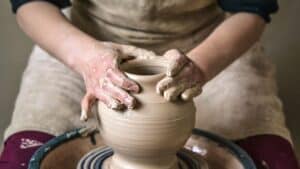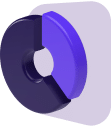Leather can be sewn by hand or with a sewing machine to attach pieces together or to add embellishments.
Leather is thick, but it is possible to skip the tedious hand sewing and opt for the convenience of a machine to tackle the hard part for you.
What’s the best leather sewing machine for beginners? A walking foot sewing machine is recommended because it can handle thick materials. Alternatively, you can purchase thick needles made for leather and walking foot attachments for your current machine to convert it to sew leather.
Many people aren’t aware that you can purchase heavy-duty sewing machines that are perfect for sewing leather or that, with a few modifications, you can even use a regular home sewing machine for leather projects.
Keep reading to learn what exactly the best options are and to see how easy it actually is to sew leather with a machine.
Recommended Sewing Machines
Leather is thicker than most materials you might typically use on your sewing machine, so you might be hesitant to try it out.
Of course, hand stitching is always an option, but fortunately, just about every home sewing machine can handle leather with a few modifications.
If you’re not sure about trying that out as a beginner, here are a couple of options for you.
The REX Portable Walking-Foot Sewing Machine is one of the best for a beginner to use because it’s sturdy and includes everything you need to start sewing leather.
This sewing machine is made of cast iron metal, so it’s heavy-duty and is guaranteed to be durable enough to sew any kind of leather.
It can also handle other thick materials such as denim or canvas, which makes it an excellent investment if you plan on using it for several different types of projects.
This sewing machine has a walking foot, so you won’t have to buy one separately.
If you’re brand new to sewing, this is a great convenience for you if you’re not sure what to look for when buying a walking foot attachment.
Plus, you can have certainty that you can finish any leather project with this machine!
The Janome HD3000 Heavy-Duty Sewing Machine is recommended for beginners who prefer a basic machine.
This is a simpler home sewing machine that is suited to sew almost any kind of material, including leather.
The sewing machine comes with leather needles and several other accessories as well, including a case, universal needles, and different kinds of sewing feet.
One thing to note about this sewing machine is that it doesn’t come with a walking foot.
A walking foot makes sewing leather much easier, so you will need to purchase one separately.
Why Do I Need a Walking Foot?
What’s a walking foot, and why do you need one if a sewing machine comes with leather needles?
A walking foot allows the sewing machine to pull the fabric that’s on top at the same speed as the fabric that’s on the bottom.
The foot is larger than regular feet and has an arm that connects to the needle bar. The arm is what tells the machine to pull both layers evenly.
The walking foot is meant to be used with unusual fabrics like fur, knits, and even leather.
You could try to sew leather without one, but it might be much more difficult.
Remember that leather doesn’t allow for mistakes like other fabrics do. Once it’s punctured with a needle, the hole will stay there and will be noticeable.
The Even Feed Walking Sewing Machine Presser Foot is recommended for beginners. It can attach to any home sewing machine with a low shank system.
The YUEWO DIY Shoe Repair Machine is a hand-crank version of the walking foot. It stands on a tripod and you turn the crank to get the needle moving.
It’s great for larger projects since it has plenty of room, and it can even be used to repair shoes!
Since it can repair shoes, it will be able to handle any thickness of leather. A beginner could easily use this, though it may take some practice.
How to Sew Leather on a Standard Machine
You can use your current home sewing machine to sew leather. This section lists several tips you should follow so you don’t damage your machine.
Since leather is thick, it can easily damage thin needles or receive damage from the wrong type of presser foot.
How do you know if a sewing machine can handle certain materials? Generally, if the material can fit under the presser foot, you should be able to sew it.
Keep in mind that tougher materials require thicker needles.
The REX and Janome sewing machines are recommended because they are made to work with the fabrics that don’t always work with home machines.
Use the Proper Presser Foot
The best option is to use a walking foot, but if you don’t want to invest in one, there are a couple of alternatives you can use that you might already own.
Use a Teflon foot or a roller foot. The regular presser foot that comes on the machine might stick to the leather and cause it to bunch up.
Teflon is nonstick and the roller presser has rolling parts that will make it impossible for the leather to stick, so either one will be better than a regular presser foot.
Use Leather Needles
You shouldn’t use regular needles when sewing leather, as they can easily break while trying to puncture the material.
Leather needles are thicker and heavier so they should be able to withstand any thickness.
I’ve found that the Schmetz Leather Machine Needles are great to work with.
They come in packs of five, which is handy as even leather needles break on occasion, especially if the leather is thick or you’re sewing through several layers.
It’s always wise to keep several needles on hand, particularly if you’re working on a big project.
Use the Right Thread and Stitch Length
Since you have to use a larger needle, it’s no surprise that you have to use a larger thread and stitch length, as well.
Don’t use cotton thread! This thread will eventually erode away due to friction and tannins in the leather that came from the leather tanning process.
Nylon or polyester thread won’t erode and will be more sturdy.
The stitch length you should use should be longer than a normal stitch but shorter than a basting stitch.
Never Use Pins
Remember that holes will remain visible in leather, so the only holes that should be in the leather are the ones made by the sewing machine when the thread was placed.
Never use pins to hold the leather in place, as that will damage the material.
Instead, use double-sided tape. You can get a dispenser like the Duck Brand Easy-Stick or just use a roll of Scotch Brand tape.
To use double-sided tape:
- Place the tape along the edge of the leather where you plan to sew.
- Place the other piece of leather on top of the tape.
- Press down gently to stick them together.
- Sew across the leather as normal.
There is no need to remove the tape!
The tape may eventually come out on its own, but there’s no reason to remove it. It’ll stay hidden in the seam and you won’t be able to tell it’s there.
Test the Leather
Before you begin working on a project, use a scrap piece of the leather you’re going to work with to make sure it works with your machine and needles.
It’s always better to mess up a scrap of leather instead of the piece you’re going to use to make something.
This is also a great way to test stitch length and thread to make sure it will work for your project.
You can try out several stitch lengths and threads to see which one will suit your project the best.
Conclusion
Sewing leather with a machine is a simple task if you have the right equipment! Always remember that leather requires a sturdy needle and machine.
Investing in a walking foot will certainly make the job easier, but a heavy-duty machine is well worth the investment, especially since these machines can also work with any other material just like a regular home sewing machine can.







